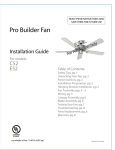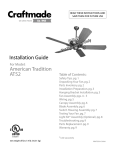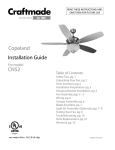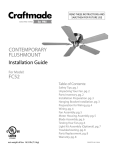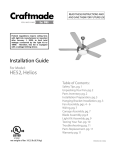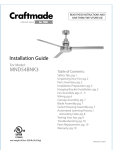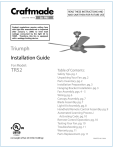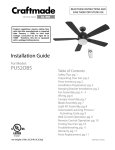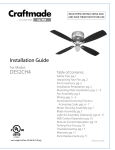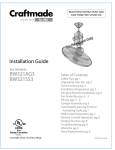Download Craftmade UH52 Installation guide
Transcript
READ THESE INSTRUCTIONS AND
SAVE THEM FOR FUTURE USE
.
O
.
F.P t Only
en
m
e
lac
P
r
Fo
Installation Guide
For Model:
UH52
E192641
net weight of fan: 11.57 lb (5.25 kg)
Table of Contents:
Safety Tips. pg. 1
Unpacking Your Fan. pg. 2
Parts Inventory. pg. 2
Installation Preparation. pgs. 2 - 3
Hanging Bracket Installation. pg. 3
Preparation for Wiring. pg. 4
Wiring. pg. 4
Fan Assembly. pg. 5
Motor Housing Assembly. pg. 5
Blade Assembly. pg. 6
Testing Your Fan. pg. 6
Light Kit* Assembly (Optional). pg. 7
Troubleshooting. pg. 8
Parts Replacement. pg. 8
Warranty. pg. 8
*sold separately
PRINTED IN CHINA
SAFETY TIPS.
WARNING: To reduce the risk of electrical shock, turn off the electricity to the fan at the main fuse box or circuit
panel before you begin the fan installation or before servicing the fan or installing accessories.
1.
READ ALL INSTRUCTIONS AND SAFETY INFORMATION CAREFULLY BEFORE INSTALLING YOUR FAN
AND SAVE THESE INSTRUCTIONS.
CAUTION: To avoid personal injury, the use of gloves may be necessary while handling fan parts with sharp
edges.
2.
3.
4.
Make sure all electrical connections comply with Local Codes or Ordinances, the National Electrical Code,
and ANSI/NFPA 70-1999. If you are unfamiliar with electrical wiring or if the house/building wires are
different colors than those referred to in the instructions, please use a qualified electrician.
Make sure you have a location selected for your fan that allows clear space for the blades to rotate, and at
least seven (7) feet (2.13 meters) of clearance between the floor and the fan blade tips. The fan should
be mounted so that the tips of the blades are at least thirty (30) inches (76 centimeters) from walls or
other upright structures.
The outlet box and ceiling support joist used must be securely mounted, and capable of supporting at
least 35 pounds (16 kilograms). The box must be supported directly by the building structure. Use only
CUL (Canada) or UL (USA) listed outlet boxes marked "FOR FAN SUPPORT."
WARNING: To reduce the risk of fire, electrical shock, or personal injury, mount to the outlet box marked
"Acceptable for Fan Support of 15.9 kg (35 lb) or less," and use the mounting screws provided with the outlet
box. Most outlet boxes commonly used for the support of lighting fixtures are not acceptable for fan support
and may need to be replaced. Consult a qualified electrician if in doubt.
WARNING: To reduce the risk of fire, electrical shock, or personal injury, wire connectors provided with this fan
are designed to accept only one 12 gauge house wire and two lead wires from the fan. If your house wire is
larger than 12 gauge or there is more than one house wire to connect to the corresponding fan lead wires,
consult an electrician for the proper size wire connectors to use.
5.
6.
7.
Electrical diagrams are for reference only. Light kits that are not packed with the fan must be CUL (Canada)
or UL (USA) listed and marked suitable for use with the model fan you are installing. Switches must be
CUL (Canada) or UL (USA) general use switches. Refer to the instructions packaged with the light kits
and switches for proper assembly.
After installation is complete, check that all connections are absolutely secure.
After making electrical connections, spliced conductors should be turned upward and pushed carefully up
into the outlet box. The wires should be spread apart with the grounded conductor and the
equipment-grounding conductor on opposite sides of the outlet box.
WARNING: To reduce the risk of fire or electrical shock, do not use this fan with any solid state speed control
device or control fan speed with a full range dimmer switch. [Using a full range dimmer switch to control fan
speed will cause a loud humming noise from fan.] (Note: This fan is suitable for use with remote control.)
8.
9.
Do not operate the fan in reverse until fan has come to a complete stop.
Do not insert anything between the fan blades while they are rotating.
WARNING: To reduce the risk of personal injury, do not bend the blade arms during assembly or after
installation. Do not insert objects into the path of the blades.
WARNING: To avoid personal injury or damage to the fan and other items, be cautious when working around or
cleaning the fan.
10.
Do not use water or detergents when cleaning the fan or fan blades. A dry dust cloth or lightly dampened
cloth will be suitable for most cleaning.
WARNING: To reduce the risk of personal injury, use only parts provided with this fan. The use of parts OTHER
than those provided with this fan will void the warranty.
NOTE: The important safety precautions and instructions appearing in the manual are not meant to cover all
possible conditions and situations that may occur. It must be understood that common sense and caution are
necessary factors in the installation and operation of this fan.
page 1
1. Unpacking Your Fan.
Carefully open the packaging. Remove items
from Styrofoam inserts. Remove motor housing
and place on carpet or Styrofoam to avoid
damage to finish. Do not discard fan carton or
Styrofoam inserts should this fan need to be
returned for repairs.
Check against parts inventory that all parts have
been included.
2. Parts Inventory.
a
b
a. hanging bracket. 1 piece
b. motor housing. 1 piece
c. motor assembly. 1 piece
c
d. blade arm. 5 pieces
d
e. blade. 5 pieces
f. hardware packs
e
f
PLEASE NOTE: Drawings in manual are representative only.
IMPORTANT REMINDER: You must use the parts provided with this fan for proper installation and safety.
3. Installation Preparation.
To prevent personal injury and damage, ensure
that the hanging location allows the blades a
clearance of 7ft. (2.13m) from the floor and 30in.
(76cm) from any wall or obstruction.
This fan is suitable for room sizes up to
400 square feet (37.2 square meters).
page 2
10ft. - 12ft.
(3.05m - 3.66m)
blade edge
30
inches
7 feet (76cm)
(2.13m)
10ft. - 12ft.
(3.05m - 3.66m)
3. Installation Preparation. (cont.)
This fan can be mounted as a flushmount
on a regular (no-slope) ceiling only. Downrod
installations are not available for this fan.
Installation requires these tools:
Phillips screwdriver, flat-head screwdriver,
adjustable pliers or wrench, stepladder, wire
cutters, and rated electrical tape.
downrod
installation
flushmount
installation
CANNOT be
installed on
angled or
vaulted ceilings
4. Hanging Bracket Installation.
Turn off circuit breakers to current fixture from
breaker panel and be sure operating light switch
is turned to the OFF position. [Refer to diagram 1.]
WARNING: Failure to disconnect power supply prior
to installation may result in serious injury.
Remove existing fixture.
WARNING: When using an existing outlet box, be
sure the outlet box is securely attached to the
building structure and can support the full weight of
the fan. Ensure outlet box is clearly marked "Suitable
for Fan Support." If not, it must be replaced with an
approved outlet box. Failure to do so can result in
serious injury.
Install hanging bracket to outlet box using
original screws, spring washers and flat washers
provided with new or original outlet box.* Install
rubber cushions between outlet box and hanging
bracket (if not already pre-attached to hanging
bracket) to reduce vibration of metal to metal
surfaces. Pull electrical wiring from outlet box
through center hole in the hanging bracket. [Refer
to diagram 3.]
*Note: It is very important that you use the proper
hardware when installing the hanging bracket as
this will support the fan.
OFF
OFF
hanging bracket
motor
mounting
nuts
flat
washers
diagram 2
rubber cushions
hanging
bracket
spring washers
outlet box screws
diagram 3
page 3
ON
diagram 1
CAUTION: Be sure outlet box is grounded properly
and that a ground wire (GREEN or bare) is present.
Remove 4 motor mounting nuts and flat washers
from hanging bracket--save for later use. [Refer to
diagram 2.]
ON
flat
washers
5. Preparation for Wiring.
Lift motor assembly to hanging bracket and slide slot
at one end of motor assembly over j-hook on
hanging bracket. This will allow motor assembly to
hang out of the way while wiring.
Tip: Seek the help of another person to hold the
stepladder in place and to lift the fan up to you once
you are set on the ladder.
Find a secure attachment point (wood ceiling joist
highly recommended) and secure safety cable. It will
be necessary to use a heavy duty wood screw, washer
and lock washer (not supplied) with the safety cable
loop. If necessary, adjust the loop at the end of the
safety cable. The loop at the end of the safety cable
should just fit over the threads on the wood screw.
Extra cable slack can be left in ceiling area.
wood joist
safety cable
loop
wood screw
and washer
safety cable
j-hook
motor assembly
6. Wiring.
(supply circuit)
CAUTION: Be sure outlet box is properly
grounded and that a ground wire (GREEN or
Bare) is present.
WHITE
wood joist
BLACK
Make sure all electrical connections comply with
Local Codes or Ordinances and the National
Electrical Code. If you are unfamiliar with
electrical wiring or if the house/building wires are
different colors than those referred to below,
please use a qualified electrician.
outlet box
hanging
When fan is secured in place on the hanging
bracket
bracket, electrical wiring can be made as
follows:
j-hook
Connect BLACK wire from fan to BLACK wire
from ceiling with wire connector provided.
Connect WHITE wire from fan to WHITE wire
from ceiling with wire connector provided.
Connect all GROUND (GREEN) wires together
from fan to BARE/GREEN wire from ceiling with
wire connector provided.
wire
connector
SWITCH
GROUND
(GREEN
OR BARE)
GREEN
BLACK
GREEN
WHITE
WHITE
BLACK
BLUE
*
Since this fan does not come with a light kit,
you will need to cap off the BLUE wire with a
wire connector (as shown with arrow in diagram
at right). [Note: If you elect to purchase a light
kit for the fan, the BLUE wire from the fan must
be connected to the BLACK wire from the
ceiling instead.]
motor assembly
* Wrap each wire connector separately with
electrical tape as an extra safety measure.
page 4
7. Fan Assembly.
Remove motor assembly from j-hook on
hanging bracket. Lift motor assembly to
hanging bracket and carefully push wiring
and wire connectors into outlet box. Align
holes in top of motor assembly with bolts
in hanging bracket and push up so that
bolts come through holes. Secure motor
assembly with flat washers and motor
mounting nuts that were previously
removed (refer to page 3, Section 4).
hanging
bracket
j-hook
motor
mounting
nuts and flat
washers
motor
mounting
nuts and
flat washers
motor assembly
8. Motor Housing Assembly.
Temporarily raise motor housing to
hanging bracket to determine which 2
screws in hanging bracket align with
slotted holes on top rim of motor housing.
Partially loosen the 2 screws in the hanging
bracket that correspond to slotted holes in
the motor housing. Remove the other 2
screws from the hanging bracket.
Now, raise motor housing to hanging
bracket again, allowing slotted holes in
motor housing to align with loosened
screws in hanging bracket. Twist motor
housing to lock. Re-insert the 2 screws that
were previously removed and then tighten
all screws to secure motor housing.
hanging
bracket
motor
housing
screws
motor
housing
page 5
motor
housing
screws
9. Blade Assembly.
Time Saver: Washers for blade screws can be set
on each blade screw prior to installing blades.
motor
housing
Locate 15 blade attachment screws and washers
in one of the hardware packs. Hold blade arm up
to blade and align holes. Insert 3 blade
attachment screws (along with washers) with
fingers first and then tighten screws securely
with a Phillips screwdriver. Repeat procedure for
the remaining blades.
blade attachment
screws and washers
J
blade
Remove blade arm screws and lock washers
from underside of motor. If plastic motor locks
are installed with blade arm screws, discard
plastic motor locks (save blade arm screws and
lock washers to secure blade arms). Align blade
arm holes with motor screw holes and attach
blade arm with lock washers and blade arm
screws. Before securing screws permanently,
repeat this procedure with remaining blade
arms. Secure all screws.
plastic
motor
lock
lock washers
Note: Tighten blade arm screws twice a year.
blade arm
blade arm
screws
10. Testing Your Fan.
It is recommended that you test fan before finalizing
installation. Restore power from circuit box and light
switch (if applicable). Test fan speeds with the pull
chain. Start at the OFF position (no blade movement).
First pull will set the fan to HI. Second pull will set the
fan to MEDIUM. Third pull will set the fan to LOW. Fourth
pull will again set the fan to the OFF setting. If fan does
not function, please refer to "Troubleshooting" section
to solve any issues before contacting Customer Service.
Turn fan completely off before moving the reverse
switch. Set reverse switch to recirculate air depending
on the season:
- DOWN position in summer (diagram 1)
- UP position in winter (diagram 2)
A ceiling fan will allow you to raise your thermostat
setting in summer and lower your thermostat setting in
winter without feeling a difference in your comfort.
Important: Reverse switch must be set either
completely UP or completely DOWN for fan to function. If
the reverse switch is set in the middle position
(diagram 3), fan will not operate.
Attach pull chain extension supplied or custom pull
chain extension (sold separately) to end of the pull
chain.
page 6
pull chain
extension
reverse
switch
diagram 1
diagram 2
diagram 3
11. Light Kit Assembly (Optional).
motor housing
WARNING: Failure to disconnect power supply at
main panel prior to light kit assembly may result in
serious injury.
IF YOU WISH TO USE YOUR FAN WITH A LIGHT KIT
(sold separately), remove 3 screws from switch
housing and then remove switch housing cap from
switch housing. (Refer to diagram a.)
Locate BLUE (or BLACK) and WHITE wires in the
switch housing labeled FOR LIGHT. Remove and
discard plastic that holds these 2 wires together.
(Refer to diagram a.)
blue (or
black) wire
switch housing
white wire
molex connections
switch housing cap
diagram a
If your light kit is to be mounted directly to switch
housing, remove 3 screws from light kit fitter (refer
to diagram b). Make wire connections as described
below.
If your light kit is to be attached by a threaded rod
(refer to diagram c), remove hex nut and lock
washer from threaded rod on light kit fitter. Punch
center cap out of switch housing cap with a
screwdriver. Push wires from light kit fitter (one by
one) through hole in middle of switch housing cap
and screw switch housing cap onto threaded rod
followed by lock washer and hex nut that were
previously removed. Tighten hex nut over lock
washer for a secure fit. Make wire connections as
described below.
Connect WHITE wire from light kit fitter to WHITE
wire from switch housing. Connect BLACK wire
from light kit fitter to BLUE (or BLACK) wire from
switch housing. Be sure molex connections snap
together securely. Align holes in switch housing
cap with holes in switch housing. Re-insert 3
screws that were previously removed and securely
tighten all 3 screws.
light kit fitter
[representative only
for directly connecting
light kit]
diagram b
switch housing cap
center cap
hex nut
lock washer
switch housing cap
light kit fitter
[representative only
for using threaded
rod to attach light kit]
diagram c
diagram d
Attach glass shade(s) to light kit fitter using the
hardware provided with the light kit. (Refer to
diagram d.)
NOTE: If you are installing a bowl fixture, the
bulb(s) must be installed first.
light kit
fitter
[representative only]
Install bulb(s) specified by the light kit. (Refer to
diagram d.) If you are installing a halogen bulb, be
sure not to handle glass directly with your fingers as
oil from the skin may shorten the life of the bulb.
IMPORTANT: When changing bulb(s), remember
to allow bulb(s) and glass shade(s) to cool before
touching.
page 7
glass shade
[representative only]
bulb
[representative only]
Troubleshooting.
Warranty.
Problem: Fan fails to operate.
Solutions:
1. Check wall switch to fan.
2. Verify that reverse switch is set completely in
either direction.
3. Check to be sure fan is wired properly.
Problem: Fan wobbles.
Solutions:
1. Use the balancing kit provided in one of the
hardware packs. If no blade balancing kit is
provided, please call Customer Support,
1-800-486-4892, to request one.
2. Carefully loosen motor housing and verify that
mounting bracket is secure.
3. Check to be sure motor housing is turned
completely and that motor housing screws are
secure.
Parts Replacement.
For parts and information, please refer to
"Parts Inventory" on page 2.
Craftmade/Ellington Customer Support:
1-800-486-4892
www.craftmadebrands.com
page 8
CRAFTMADE/ELLINGTON 30-YEAR WARRANTY:
CRAFTMADE/ELLINGTON warrants this fan to the original
household purchaser for indoor use under the following
provisions:
1-YEAR WARRANTY: CRAFTMADE/ELLINGTON will replace
or repair any fan which has faulty performance due to a
defect in material or workmanship. Contact
Craftmade/Ellington Customer Service at
1-800-486-4892 to arrange for return of fan. Return fan,
shipping prepaid, to Craftmade/Ellington. We will repair or
ship you a replacement fan, and we will pay the return
shipping cost.
5-YEAR WARRANTY: CRAFTMADE/ELLINGTON will repair or
replace at no charge to the original purchaser any fan
motor that fails to operate satisfactorily when failure
results from normal use.
RETURN FAN MOTOR ONLY, shipping prepaid, to
Craftmade/Ellington. We will repair or ship purchaser a
replacement motor and Craftmade/Ellington will pay the
return shipping cost.
6 to 30-YEAR LIMITED WARRANTY:
CRAFTMADE/ELLINGTON will repair the fan, at no charge
for labor only to the original purchaser, if the fan motor
fails to operate satisfactorily when failure results from
normal use. Parts used in the repair will be billed to the
purchaser at prevailing prices at time of repair.
The purchaser shall be responsible for all costs incurred
in the removal, reinstallation and shipping of the product
for repairs.
This warranty does not apply when damage from
mechanical, physical, electrical or water abuse results in
causing the malfunction. Deterioration of finishes or other
parts due to time or exposure to salt air is specifically
exempted under this warranty.
Neither Craftmade/Ellington nor the manufacturer will
assume any liability resulting from improper installation or
use of this product. In no case shall the company be liable
for any consequential damages for breach of this, or any
other warranty expressed or implied whatsoever. This
limitation as to consequential damages shall not apply in
states where prohibited.
LEER ESTAS INSTRUCCIONES Y
GUARDARLAS PARA UTILIZACION FUTURA
. ly
O
.
P
F.
t On
For
en
m
e
Plac
Guía de instalación
Para modelo:
UH52
Indice de materias:
Sugerencias de seguridad. Pág. 1
Desempaquetado del ventilador. Pág. 2
Inventario de piezas. Pág. 2
Preparación para la instalación. Págs. 2 - 3
Instalación del soporte de montaje. Pág. 3
Preparación para la instalación eléctrica. Pág. 4
Instalación eléctrica. Pág. 4
Ensamblaje del ventilador. Pág. 5
Colocación del bastidor del motor. Pág. 5
Colocación de las aspas. Pág. 6
Verificación del funcionamiento del
ventilador. Pág. 6
Instalación del juego de luz* (opcional). Pág. 7
Localización de fallas. Pág. 8
Piezas de repuesto. Pág. 8
Garantía. Pág. 8
E192641
peso neto del ventilador: 5,25 kg (11,57 lb)
*a la venta por separado
IMPRESO EN CHINA
SUGERENCIAS DE SEGURIDAD.
ADVERTENCIA: Para evitar la posibilidad de una descarga eléctrica, desconectar la corriente en la caja de fusibles principal
o el interruptor protector antes de iniciar la instalación del ventilador o antes de repararlo o instalar accesorios.
1.
LEER TODAS LAS INSTRUCCIONES E INFORMACIÓN DE SEGURIDAD CUIDADOSAMENTE ANTES DE INSTALAR
SU VENTILADOR Y GUARDAR ESTAS INSTRUCCIONES.
PRECAUCION: Para reducir el riesgo de daño corporal, es posible que sea necesario usar guantes al manejar las piezas del
ventilador que tengan bordes afilados.
2.
3.
4.
Asegurarse de que todas las conexiones eléctricas cumplan con los Códigos o las Ordenanzas Locales, el Código
Nacional Eléctrico, y ANSI/NFPA 70-1999. Si usted no está familiarizado con el alambrado eléctrico o los cables de
la casa/el edificio son de colores diferentes a los cuales se refieren en las instrucciones, favor de buscar un
electricista calificado.
Asegurarse de que haya localizado una ubicación para su ventilador que permite el espacio necesario para la rotación
de las aspas y por lo menos 2,13 metros (7 pies) de espacio libre entre el piso y las puntas de las aspas. Debe
instalar el ventilador para que las puntas de las aspas queden a una distancia de por lo menos 76 centímetros
(30 pulgadas) de las paredes y otras estructuras verticales.
La caja de salida eléctrica debe estar bien sujetada a la viga de soporte del techo y deben ser capaces de sostener por
lo menos 16 kilogramos (35 libras). La caja debe tener apoyo directo de la estructura del edificio. Sólo usar cajas
de salida registradas con CUL (Canadá) o UL (EEUU) que indican que "sirven para ventilador" ("FOR FAN SUPPORT"
en inglés).
ADVERTENCIA: Para reducir el riesgo de incendio, descarga eléctrica o daño corporal, instalar en la caja de salida marcada
"Aceptable para sostener ventilador de 15,9 kg (35 lb) o menos" ["Acceptable for Fan Support of 15.9 kg (35 lb) or less"] y
utilizar los tornillos proporcionados con la caja de salida. La mayoría de las cajas de salida que normalmente se usan para
sostener los aparatos de alumbrado no siempre son apropiadas para sostener ventiladores y es posible que las tenga que
reemplazar. En caso de duda, consultar con un electricista calificado.
ADVERTENCIA: Para reducir el riesgo de incendio, descarga eléctrica o daño corporal, los conectores para cable provistos
con este ventilador son diseñados para aceptar sólo un cable de calibre 12 de la casa y dos cables principales del ventilador.
Si el calibre del cable de la casa es superior al 12 o hay más de un cable de la casa para conectar a los cables principales del
ventilador al cual corresponda cada uno, consultar con un electricista para informarse sobre el tamaño correcto de
conectores para cable que se debe usar.
5.
6.
7.
Los diagramas eléctricos son únicamente para referencia. Los juegos de luz que no se incluyen con el ventilador
deben tener el símbolo CUL (Canadá) o UL (EEUU) y también deben indicar que sirven para uso con este ventilador.
Los interruptores deben ser interruptores de uso general CUL (Canadá) o UL (EEUU). Referirse a las instrucciones
incluidas con el juego de luz y los interruptores para ensamblarlos correctamente.
Después de haber terminado la instalación, asegurarse de que todas las conexiones estén totalmente seguras.
Después de haber terminado todas las conexiones eléctricas, los conductores empalmados deben ser volteados para
arriba y colocados cuidadosamente dentro de la caja de salida. Los alambres se deben de separar con el
conductor a tierra a un lado y el conductor a tierra del equipo al lado opuesto.
ADVERTENCIA: Para reducir el riesgo de incendio o una descarga eléctrica, no usar el ventilador con ningún control de
velocidad de estado sólido ni controlar la velocidad del ventilador con un interruptor con reductor de luz de gama
completa. [El usar un interruptor con reductor de luz de gama completa para controlar la velocidad del ventilador causará
un zumbido recio del ventilador.] (Nota: Este ventilador sí sirve para usar con control remoto.)
8.
9.
No utilizar el interruptor de reversa hasta que el ventilador se haya parado completamente.
No insertar ningún objeto entre las aspas mientras estén rotando.
ADVERTENCIA: Para reducir el riesgo de daño corporal, no doblar los brazos de las aspas durante el ensamblaje ni durante
la instalación. No insertar objetos entre las aspas mientras estén rotando.
ADVERTENCIA: Para reducir el riesgo de daño corporal o algún daño al ventilador, tener cuidado al estar trabajando
alrededor del ventilador o limpiándolo.
10.
No utilizar agua ni detergentes para limpiar el ventilador ni las aspas. Usar un trapo seco o ligeramente húmedo
para su limpieza general.
ADVERTENCIA: Para reducir el riesgo de daño corporal, usar sólo las piezas provistas con este ventilador. Al usar piezas
DISTINTAS a las provistas con este ventilador se invalidará la garantía.
NOTA: No se debe concluir que las precauciones de seguridad importantes e instrucciones en este manual van a abarcar
todas las condiciones y situaciones posibles que puedan ocurrir. Se debe entender que el sentido común y la precaución
son factores necesarios en la instalación y la operación de este ventilador.
página 1
1. Desempaquetado del ventilador.
Abrir el empaque cuidadosamente. Sacar los artículos
del embalaje. Sacar el motor y ponerlo en una
alfombra o en el embalaje para evitar rayar el acabado.
Guardar la caja de cartón o el empaquetamiento
original en caso de que tenga que mandar el
ventilador para alguna reparación.
Comprobar las piezas del ventilador con el inventario
de piezas y verificar que se incluyeron todas.
2. Inventario de piezas.
a
b
a. soporte de montaje. 1 unidad
b. bastidor del motor. 1 unidad
c
c. unidad del motor. 1 unidad
d. brazo para el aspa. 5 unidades
d
e. aspa. 5 unidades
f. paquetes de artículos de ferretería
e
f
FAVOR DE DARSE CUENTA: Los dibujos en el manual sólo son representativos.
RECORDATORIO IMPORTANTE: Se tienen que utilizar las piezas provistas con este ventilador para una instalación
adecuada y su seguridad.
Para prevenir daño corporal y otros daños, estar
seguro de que el lugar en donde va a colgar el
ventilador le permite un espacio libre de 2,13m
(7 pies) entre las puntas de las aspas y el piso y
76cm (30 pulg.) entre las aspas y cualquier pared u
otra obstrucción.
Este ventilador es adecuado para habitaciones
hasta 37,2 metros cuadrados (400 pies cuadrados).
página 2
3,05m - 3,66m
10 pies - 12 pies
3. Preparación para la instalación.
borde del aspa
76cm
(30
2,13m pulg.)
(7 pies)
3,05m - 3,66m
3. Preparación para la instalación. (cont.)
Este ventilador se puede colgar solamente al ras
con el techo en un techo regular (sin inclinación).
No se puede hacer instalación con tubo con este
ventilador.
instalación al ras
con el techo
Se necesitan las herramientas siguientes para la
instalación:
Destornillador de estrella Phillips, destornillador de
paleta (plano), alicates ajustables o llave de tuercas,
escalera de tijera, cortaalambres y cinta aisladora.
instalación
con tubo
NO se permite
instalar en
techo angulado
ni abovedado.
4. Instalación del soporte de montaje.
Apagar los cortacircuitos en el panel de electricidad
que suplen corriente a la caja de salida y asegurarse
de que el interruptor de luz esté APAGADO. [Referirse
al diagrama 1.]
ADVERTENCIA: El no desconectar el suministro de
fuerza antes de la instalación puede tener por resultado
lesiones graves.
Quitar el aparato existente.
ADVERTENCIA: Si utiliza una caja de salida existente,
asegurarse de que la caja de salida esté firmemente
conectada a la estructura del edificio y que sea capaz de
sostener el peso total del ventilador. Asegurarse de que
la caja de salida indique claramente que "Sirve para
ventilador" (FOR FAN SUPPORT); si no, se debe
reemplazar con una caja de salida aprobada. El no
hacer el cambio si es necesario puede resultar en
lesiones graves.
Instalar el soporte de montaje utilizando los tornillos
originales, las arandelas de resorte y las arandelas
planas de su nueva o existente caja de salida.* Instalar
las arandelas de hule (si no vienen fijadas de
antemano al soporte de montaje) entre el soporte de
montaje y la caja de salida para reducir la vibración
entre las superficies de metal. Pasar el alambrado
eléctrico (los cables) de la caja de salida por el agujero
de en medio del soporte de montaje. [Referirse al
diagrama 3.]
*Nota: Es muy importante usar los artículos de ferretería
correctos al instalar el soporte de montaje puesto que
sirve para sostener el ventilador.
página 3
ON
OFF
OFF
diagrama 1
soporte de montaje
tuercas
para
montaje
del motor
PRECAUCION: Asegurarse de que la caja de salida esté
conectada a tierra correctamente y que haya un
conductor a tierra (VERDE o pelado).
Quitar las 4 tuercas para montaje del motor y las
arandelas planas del soporte de montaje--guardarlas
para uso más adelante. [Referirse al diagrama 2.]
ON
arandelas
planas
diagrama 2
arandelas de hule
soporte de
montaje
arandelas de resorte
tornillos de la
caja de salida
diagrama 3
arandelas
planas
5. Preparación para la instalación eléctrica.
viga de
madera
Subir la unidad del motor al soporte de montaje y colocar la
extremidad de la unidad del motor que tenga ranura en el
gancho en forma de "j" que se encuentra en el soporte de
montaje. Esto permitirá que la unidad del motor
permanezca a un lado mientras hace la instalación eléctrica.
Sugerencia: Solicitar ayuda de otra persona para mantener
sujeta la escalera y para que le suba el ventilador cuando
usted ya esté preparado en la escalera para colgarlo.
Encontrar un punto de acoplamiento seguro (se
recomienda la viga de madera en el techo) y asegurar el
cable de seguridad. Utilizar tornillo para madera para
trabajos pesados, arandela y arandela de seguridad (no
provistos) en el bucle del cable de seguridad. Si es
necesario, ajustar el bucle en el extremo del cable de
seguridad. El bucle en el extremo del cable de seguridad
debe ser de tal tamaño que pase justo sobre la punta de la
parte roscada del tornillo para madera. Se puede poner el
cable en exceso en el área del techo.
bucle del
cable de
seguridad
tornillo para
madera
y arandela
cable de
seguridad
gancho
en forma
de "j"
unidad del motor
6. Instalación eléctrica.
(fuente de
alimentación)
PRECAUCION: Asegurarse de que la caja de salida esté
conectada a tierra como es debido y que exista un
conductor a tierra (VERDE o pelado).
Asegurarse de que toda conexión eléctrica cumpla con
los Códigos o las Ordenanzas Locales y el Código
Nacional Eléctrico. Si usted no está familiarizado con la
instalación eléctrica o los cables de la casa/el edificio
son de colores diferentes a los cuales se refieren a
continuación, favor de buscar un electricista calificado.
BLANCO
viga de
madera
* Como una medida de seguridad adicional, envolver
cada conector para cable por separado con cinta
aisladora.
página 4
conector
para cable
INTERRUPTOR
caja de
salida
Una vez que el ventilador esté bien sujeto en el
soporte de
soporte de montaje, se puede hacer la instalación
montaje
eléctrica como sigue:
Conectar el cable NEGRO al cable NEGRO del techo
gancho
con un conector para cable provisto.
en forma
Conectar el cable BLANCO del ventilador al cable
de "j"
BLANCO del techo con un conector para cable
provisto.
Conectar todos los conductores a TIERRA (VERDES)
del ventilador al cable PELADO/VERDE del techo con
un conector para cable provisto.
Puesto que este ventilador no incluye juego de luz, es
necesario colocar un conector para cable en la punta
del cable AZUL (como se indica con la flecha en el
diagrama). [Nota: Si elige comprar juego de luz para el
ventilador, hay que conectar el cable AZUL del
ventilador al cable NEGRO del techo en lugar de eso.]
NEGRO
TOMA DE
TIERRA (VERDE
O PELADA)
VERDE
NEGRO
VERDE
BLANCO
BLANCO
NEGRO
AZUL
*
unidad del motor
7. Ensamblaje del ventilador.
Quitar la unidad del motor del gancho en
forma de "j" en el soporte de montaje. Subir
la unidad del motor al soporte de montaje
y con cuidado meter el cableado y los
conectores para cable dentro de la caja de
salida. Alinear los agujeros en la parte
superior de la unidad del motor con los
pernos en el soporte de montaje y empujar
hacia arriba para que los pernos pasen por
los agujeros. Asegurar la unidad del motor
usando las arandelas planas y las tuercas
para montaje del motor que se quitaron
anteriormente (referirse a la página 3,
sección 4).
soporte de
montaje
gancho en
forma de "j"
tuercas para
montaje
del motor y
arandelas
planas
tuercas para
montaje
del motor y
arandelas
planas
unidad
del motor
8. Colocación del bastidor del motor.
Temporalmente subir el bastidor del motor
al soporte de montaje para determinar
cuáles 2 tornillos en el soporte de montaje
se alinean con los agujeros con ranura en el
borde superior del bastidor del motor.
Aflojar parcialmente los 2 tornillos en el
soporte de montaje que correspondan a los
agujeros con ranura en el bastidor del
motor. Quitar los otros 2 tornillos del
soporte de montaje.
Ahora, subir el bastidor del motor hasta el
soporte de montaje de nuevo, dejando que
los agujeros con ranura en el bastidor del
motor se alineen con los tornillos aflojados
en el soporte de montaje. Girar el bastidor
del motor para cerrarlo. Volver a introducir
los 2 tornillos que se quitaron anteriormente
y apretar todos los tornillos para asegurar el
bastidor del motor.
soporte de
montaje
tornillos
para el
bastidor
del motor
bastidor
del motor
página 5
tornillos
para el
bastidor
del motor
9. Colocación de las aspas.
Para ahorrar tiempo: Se pueden poner las arandelas en
los tornillos que son para las aspas antes de colocar las
aspas.
bastidor
del motor
Localizar 15 tornillos para fijar las aspas y 15 arandelas en
uno de los paquetes de artículos de ferretería. Agarrar uno
de los brazos para las aspas y juntarlo con una de las aspas
para alinear los agujeros. Introducir 3 tornillos para fijar las
aspas (junto con arandelas) con los dedos primero y luego
apretar los tornillos bien con un destornillador de estrella
Phillips. Repetir el procedimiento con las demás aspas.
Sacar los tornillos para los brazos para el aspa y las
arandelas de seguridad del lado inferior del motor. Si se
han instalado soportes de plástico con los tornillos para el
brazo para el aspa, desechar los soportes de plástico
(guardar los tornillos para el brazo para el aspa y las
arandelas de seguridad para asegurar los brazos para el
aspa). Alinear los agujeros de uno de los brazos para las
aspas con los agujeros para los tornillos en el motor y fijar
el brazo para el aspa con arandelas de seguridad y
tornillos para el brazo para el aspa. Antes de apretar los
tornillos bien, repetir el mismo procedimiento con los
demás brazos para las aspas. Apretar bien todos los
tornillos.
tornillos y arandelas
para fijar el aspa
J
aspa
soporte
de plástico
brazo para
el aspa
arandelas
de seguridad
tornillos para el
brazo para el aspa
Nota: Apretar los tornillos para los brazos para el aspa dos
veces al año.
10. Verificación del funcionamiento del ventilador.
Se le recomienda poner el ventilador a prueba antes de terminar
la instalación. Regresar la corriente de electricidad en el
cortacircuitos y encender el interruptor de la luz en la pared (si se
aplica). Verificar las velocidades del ventilador con la cadena de
encendido. Empezar en estado de APAGADO (sin movimiento de
las aspas). Con el primer tirón el ventilador estará en marcha
ALTA. El segundo tirón controla el ventilador para que se baje a
marcha MEDIA. El tercer tirón bajará el ventilador a marcha BAJA.
Con el cuarto tirón se APAGARÁ el ventilador de nuevo. Si el
ventilador no funciona, favor de referirse a la sección
"Localización de fallas" para resolver cualquier asunto antes de
comunicarse con el Servicio al Cliente.
Apagar el ventilador completamente antes de mover el
interruptor de reversa. Regularlo para que se circule bien el aire
dependiendo de las estaciones del año:
- posición ABAJO en verano (diagrama 1)
- posición ARRIBA en invierno (diagrama 2)
Un ventilador de techo le permitirá subir el termostato en verano
y bajarlo en invierno sin notar una diferencia en su comodidad.
Importante: Hay que mover el interruptor de reversa o
completamente hacia ARRIBA o completamente hacia ABAJO para
que funcione el ventilador. Si el interruptor de reversa está
puesto en la posición de en medio (diagrama 3), no funcionará el
ventilador.
Fijar la extensión para la cadena de encendido provista a la
cadena de encendido o usar una hecha a medida (a la venta por
separado).
página 6
extensión
para la
cadena de
encendido
interruptor
de reversa
diagrama 1
diagrama 2
diagrama 3
11. Instalación del juego de luz (opcional).
bastidor
del motor
ADVERTENCIA: El no desconectar el suministro de fuerza
eléctrica en el panel principal antes de instalar el juego de luz
puede causar lesiones graves.
SI DESEA UTILIZAR EL VENTILADOR CON JUEGO DE LUZ
(a la venta por separado), quitar los 3 tornillos de la caja de
encendido. Quitar la cubierta de la caja de encendido de la
caja de encendido. (Referirse al diagrama a.)
Localizar los cables AZUL (o NEGRO) y BLANCO en la caja
de encendido con etiqueta que diga "FOR LIGHT" (PARA LA
LUZ). Quitarles y tirar el plástico que liga los 2 cables.
(Referirse al diagrama a).
Si se va a sujetar el juego de luz directamente a la caja de
encendido, quitar los 3 tornillos del conectador para el
juego de luz (referirse al diagrama b). Hacer las conexiones
alámbricas como se describe más abajo. Si se va a sujetar el
juego de luz con una varilla roscada (referirse al diagrama
c), quitar la tuerca hexagonal y la arandela de seguridad
del conectador para el juego de luz. Perforar la cubierta de
la caja de encendido con destornillador en el mero centro
para que se caiga la tapa. Pasar los cables del conectador
para el juego de luz (uno por uno) por el agujero de en
medio de la cubierta de la caja de encendido y atornillarla
en la varilla roscada. Después bajar la arandela de
seguridad y la tuerca hexagonal que se habían quitado
anteriormente. Apretar la tuerca hexagonal encima de la
arandela de seguridad para que se queden bien ajustados.
Hacer las conexiones alámbricas así como se describe a
continuación.
Conectar el cable BLANCO del conectador para el juego
de luz al cable BLANCO de la caja de encendido. Conectar
el cable NEGRO del conectador para el juego de luz al
cable AZUL (o NEGRO) de la caja de encendido.
Asegurarse de que se conecten bien las conexiones tipo
molex. Alinear los agujeros en la cubierta de la caja de
encendido con los agujeros en la caja de encendido.
Volver a introducir los 3 tornillos que se quitaron
anteriormente y apretar bien los 3 tornillos.
Colocar la(s) pantalla(s) de vidrio al conectador para el
juego de luz con los artículos de ferretería provistos con el
juego de luz. (Referirse al diagrama d.)
Nota: Si instala un globo, hay que instalar la(s) bombilla(s)
primero.
Instalar la(s) bombilla(s) especificada(s) en el juego de luz.
(Referirse al diagrama d.) Si instala una bombilla halógena,
tener cuidado de no tocar el cristal directamente con los
dedos porque el aceite de la piel puede afectar la durabilidad
de la bombilla.
Importante: Cuando necesite cambiar las bombillas,
recordar dejar que se enfríen la(s) bombilla(s) y la(s)
pantalla(s) de vidrio antes de tocarlas.
página 7
cable azul
(o negro)
caja de
encendido
cable blanco
conexiones tipo "molex"
cubierta de la
caja de encendido
diagrama a
conectador para
el juego de luz
[sólo representativo,
para conexión directa
del juego de luz]
diagrama b
cubierta de la
caja de encendido
tapa
tuerca hexagonal
arandela
de seguridad
cubierta de la
caja de encendido
conectador
para el
juego de luz
[sólo representativo,
para conexión del
juego de luz con
varilla roscada]
diagrama c
diagrama d
conectador
para el
juego de luz
[sólo representativo]
pantalla de vidrio
[sólo representativa]
bombilla
[sólo representativa]
Localización de fallas.
Garantía.
ADVERTENCIA: El no desconectar el suministro de
GARANTIA LIMITADA DE 30 AÑOS DE
CRAFTMADE/ELLINGTON:
CRAFTMADE/ELLINGTON garantiza este ventilador al
comprador original de grupo familiar para uso interior con
las siguientes condiciones:
GARANTIA DE 1 AÑO: CRAFTMADE/ELLINGTON reemplazará
o reparará cualquier ventilador que tenga funcionamiento
deficiente debido a defectos en los materiales o trabajo
manual. Comunicarse con el Servicio al cliente de
CRAFTMADE/ELLINGTON al
1-800-486-4892 para acordar el reenvío del ventilador.
Devolver el ventilador, con los gastos de envío propagados,
a Craftmade/Ellington. Nosotros repararemos o
reemplazaremos el ventilador y pagaremos los gastos de
envío de regreso.
GARANTIA DE 5 AÑOS: CRAFTMADE/ELLINGTON
reemplazará o reparará sin costo al comprador original,
cualquier motor de ventilador que no funcione de manera
satisfactoria a causa de uso normal.
DEVOLVER EL MOTOR SOLAMENTE, los gastos de envío
propagados, a Craftmade/Ellington. Nosotros repararemos
el motor al comprador o le enviaremos uno de reemplazo y
Craftmade/Ellington pagará los gastos de envío de regreso.
GARANTIA LIMITADA DE 6 a 30 AÑOS:
CRAFTMADE/ELLINGTON reparará el ventilador, sin costo al
comprador original por el coste laboral, si el motor del
ventilador no funciona satisfactoriamente a causa del uso
normal. Las piezas que se utilizan en hacer la reparación
serán facturadas al comprador a los precios prevalecientes
en el momento de la reparación.
El comprador original será responsable de todos los
gastos incurridos en sacar, reinstalar y enviar el producto
para reparación.
Esta garantía no se aplica cuando el ventilador tenga
daños por abuso mecánico, físico, eléctrico o por agua
resultando en su mal funcionamiento. Se exenta
específicamente el deterioro en el acabado u otras partes
debido al tiempo o exposición al aire marino bajo esta
garantía.
Ni Craftmade/Ellington ni el fabricante se harán
responsables por lo que pasa por una instalación
inadecuada o el uso impropio de este producto. La
compañía no se hará responsable en ningún caso de ningún
daño emergente por incumplimiento de esta o cualquier
otra garantía expresada o implicada en absoluto. Esta
limitación de daños emergentes no se aplicará en estados
donde es prohibido.
fuerza eléctrica antes de hacer localización de fallas
para cualquier problema de instalación eléctrica
puede causar lesiones graves.
Problema: El ventilador no funciona.
Soluciones:
1. Inspeccionar el interruptor de pared del
ventilador.
2. Verificar que el interruptor de reversa del
ventilador está en una sola posición, no en
medio de las dos.
3. Verificar la instalación eléctrica del
ventilador.
Problemas: El ventilador se tambalea.
Soluciones:
1. Usar el juego para balancear las aspas
incluido en uno de los paquetes de artículos
de ferretería. Si no se incluye un juego para
balancear las aspas, llamar al Servicio al cliente,
1-800-486-4892, para pedir uno.
2. Con cuidado aflojar el bastidor del motor y
averiguar que el soporte de montaje está
seguro.
3. Averiguar que se giró completamente el
bastidor del motor y que se quedaron bien
apretados los tornillos para el bastidor del
motor.
Piezas de repuesto.
Para piezas o información, referirse al
"Inventario de piezas" en la página 2.
Servicio al cliente de Craftmade/Ellington:
1-800-486-4892
www. craftmadebrands.com
página 8


















